STUDY ON IMPLEMENTATION OF GMP AND SSOP OF YELLOWFIN SOLE (Limanda aspera) SANDWICH PRODUCTS AT PT BUMI MENARA INTERNUSA SURABAYA
Abstract
Keywords
Full Text:
PDFReferences
[BSN] Badan Standar Nasional. 2006. SNI 2332.1-2006. Cara uji mikrobiologi - Bagian 1: Penentuan Coliform dan Escherichia coli pada produk perikanan. Badan Standar Nasional: Jakarta.
[BSN] Badan Standar Nasional. 2006. SNI 2332.2-2006. Cara uji mikrobiologi - Bagian 2: Penentuan Salmonella pada produk perikanan. Badan Standar Nasional: Jakarta.
[BSN] Badan Standar Nasional. 2006. SNI 2332.3-2006. Cara uji mikrobiologi-Bagian 4: Penentuan Vibrio cholerae pada produk perikanan. Badan Standar Nasional: Jakarta.
[BSN] Badan Standar Nasional. 2006. SNI 2332.3-2006. Cara uji mikrobiologi-Bagian 4: Penentuan Vibrio cholerae pada produk perikanan. Badan Standar Nasional: Jakarta
[BSN] Badan Standar Nasional. 2020. SNI 2696-2020. Fillet Ikan Beku. Badan Standar Nasional: Jakarta.
[BSN] Badan Standar Nasional. 2020. SNI 4110-2020. Ikan Beku. Badan Standar Nasional: Jakarta.
Albana, UKA. (2022). Microbiological quality of imported frozen fish fillets in Kosovar markets. Internasional Journal of Research – GRANTHAALAYAH. 10(12): 38-43.
Al Sanje, S., & Karim, Md. E. (2016). Microbiological quality assessment of frozen fish and fish processing materials from Bangladesh. Internasional Journal of Food Science. 2016(1):1-6.
Astawan, M. (2019). Penanganan dan Pengolahan Hasil Perikanan. Universitas Terbuka.
Beuchat, L. R., Komitopoulou, E., Beckers, H., Betts, R., Bourdichon, F., Fanning, S., Joosten, H. M., & Kule, B. H. (2013). Low-water activity foods: increased concern as vehicles of foodborne pathogens. Journal of Food Protection. 76(1): 150-172.
Darwis, C. F. (2012). Penerapan Hazard Analytical Crytical Control Point (HACCP) dan Statistical Process Control (SPC) Dalam Proses Produksi Bumbu Penyedap Rasa di PT. Unilever Indonesia Tbk. Bogor: Skripsi Fakultastas Teknologi Pertanian.Institut Pertanian Bogor.
De Saouza, M. L. R. (2002). Comparison of six filleting methods and their relation with fillet yield and by-products of nile tilapia (Oreochromis niloticus) processing. Revista Brasileira de Zootecnia. 31(3): 1076-1084.
Fujianti, E. (2015). Perbedaan BOD, COD, Cl2, TSS Pada Inlet dan Outlet Instalasi Pengolahan Air Limbah (IPAL)(Studi Pada Industri Pengalengan Ikan PT. X di Kecamatan Muncar Kabupaten Banyuwangi. Jember: repository.unej.ac.id.
Hanidah, I., Mulyono, A. T., Andoyo, R., Mardawati, E., & Huda, S. (2018). Penerapan Good Manufacturing Practices Ebagai Upaya Peningkatan Kualitas Produk Olahan Pesisir Eretan Indramayu. Agricore: Jurnal Agribisnis Dan Sosial Ekonomi Pertanian, 3(1), 359–426.
Kementrian Kelautan dan Perikanan. (2013). Surat Keputusan Menteri Kelautan dan Perikanan tentang Persyaratan Jaminan Mutu dan Kemanan Hasil Perikanan pada Proses Produksi, pengolahan dan Distribusi, Pub.L. No. Nomor 52A/KEPMEN-KP/2013. Jakarta.
Markenih, E. (2016). Sanitasi dan Higienitas serta Pengaruhnya terhadap Kualitas Ikan yang Didaratkan di Pelabuhan Perikanan Pantai Blanakan, Subang. Institut Pertanian Bogor.
Panjaitan, F. C. A., Samanta, P. N., Utari, S. P. S. D., & Sitepu, G. S. Br. (2024). Implementation of cold chain system in peeled deveined tail-on vannamei shrimp (Litopenaeus vannamei) products. Jurnal Pangan dan Agroindustri. 12(2): 67-78.
Panjaitan, P. S., Yanni, I., Rizkiah, R., & Soeprijadi, L. (2024). Study Of Cunang Fish Fillets (Muraenesox Cinerus) Frozen With The Implementation Of Gmp And Ssop. Fisheries Journal, 1018-1020.
Pranata, I. M. R., Darmadi, N. M., & Kawan, I. M. (2024). The implementation Of GMP, SSOP, and HACCP in the processing of frozen y ellowfin tuna (Thunnus Albacares) at UD Damena. East Asian Journal of Multidisciplinary Research (EAJMR). 3(7): 2611 – 2630.
Pusporini, P., & Dahdah, S. S. (2020). The conceptual framework of cold chain for fishery products IN Indonesia. Food Science and Technology. 8(2): 28-33.
Radityo, C. T., Darmanto, Y., & Romadhon. (2014). Pengaruh Penambahan Egg White Powder dengan Konsentrasi 3% Terhadap Kemampuan Pembentukan Gel Surimi dari Berbagai Jenis Ikan. Jurnal Pengolahan dan Bioteknologi Hasil Perikanan, 1-9.
Riadi, S., Damar, A., Purnamadewi, Y. L., Pertiwi, S., & Wahyudin, Y. (2025). Optimizing capacity, occupancy, and turnover rate of fisheries cold storages in Lampung Province: a needs analysis. BIO Web of Conference. 169: 01011.
Roiska, R., Masengi, S., & Sipahutar, Y. H. (2017). Penetapan dan Pengendalian Critical Control Point (CCP) Pada Pengolahan Sotong (Sepia sp) Utuh Beku (Frozen Whole Clean Cuttlefish) di PT. Yasuriang Samudera Rezeki, Medan Belawan-Sumatera Utara. Jurnal Teknologi Dan Penelitian Terapan STP, 20(2), 109–122.
Sofyan , M. S., Mohamad, S., & Siti, E. R. (2021). Peningkatan usaha produk asal hewan sesuai SNI halal pada industri rumah tangga di desa laban kecamatan menganti kabupaten gresik. Jurnal Pengabdian Masyarakat, 2 (1) 16-23.
Trijayanto, M. A., dan Abdulrahim, M. (2021). Analisis penerapan HACCP (Hazard Analysis Criticial Control Point) pada proses produksi fillet ikan kakap dI PT. Alam Jaya untuk menjaga kualitas produk. Jurnal Taguchi. 3(1): 839-851.
Tatontos, S. J., Mongi, E. L., Wonggo, D., Montolalu, L. A., Makapedua, D. M., Dotulong, V., & Harikedua, S. D. (2019). Efek Pembekuan Pelelehan Berulang Terhadap Mutu Sensori Ikan Cakalang (Katsuwonus pelamis L). Media Teknologi Hasil Perikanan, 7(2):32-35.
Ujianti, R. D. (2017). Produksi Bersih Pada Industri Pangan Berbasis Perikanan (Cleaner Production in Food Fisheries Industrial). Jurnal Ilmu Pangan Dan Hasil Pertanian.https://doi.org/10.26877/jiphp.v1i1.1383, 1(1), 28–36. Retrieved from https://doi.org/
DOI: http://dx.doi.org/10.15578/aj.v7i1.14375
Refbacks
- There are currently no refbacks.
Public Services

Citation
Pusat Penelitian dan Pengabdian Kepada Masyarakat
Politeknik Kelautan dan Perikanan Dumai
Jl. Wan Amir No. 1, Kel. Pangkalan Sesai, Kec. Dumai Barat, Kota Dumai
Telp/Fax: (0765) 4300443
This work is licensed under a Creative Commons Attribution-ShareAlike 4.0 International License.
View My Stats


















